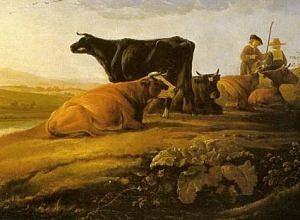
If you wish to understand yourself,
seek yourself in the wideness of the world;
if you wish to understand the world,
seek in the depths of your own mind.
Rudolf Steiner
The four ethers
Whereas you can perceive the elements as external phenomena, you can't perceive the ethers directly. You can, however, perceive their effects through the elements. The elements are found on earth; they are bound to it and attracted to it. This is most clearly the case for the solid element, least so for the warmth element.
The opposite is true for the ethers. They arise from the environment and their effect runs counter to that of the earth's gravitation. They work from the cosmos, and attract earthly matter. An example of such an ether working from the cosmos is light. You can observe the force of light when a seed germinates into a plant, which starts to grow and elongate upwards, breaks through the asphalt surface and grows towards the light. The plant grows away from the earth and towards the light, that is, towards the cosmos. Light gives the plant power to overcome gravity. The etheric force overcomes the weight of material substance.
There are four types of ether: warmth ether, light ether, chemical or tone ether and life ether:
- Warmth ether is the etheric side of warmth: the inner, impulse-creating warmth or the warmth of enthusiasm that occurs as the intention that underlies actions. Its elemental counterpart is fire, or externally perceivable warmth. Warmth ether and warmth as an element are closely related.
- Light ether illuminates everything and makes all material things visible. It is also the force which makes plants grow upwards and makes people stand and walk upright. Light ether corresponds to the air element.
- Chemical or tone ether is the force that structures the development of phenomena and can be seen, for instance, in the natural succession of plant communities. Chemical ether corresponds to the water element.
- Life ether is the force that makes an object and its environment appear as a unified whole. It is the force that unifies an object's course of life. Life ether corresponds to the earth element.
Warmth ether
Warmth is the most rarefied element, and is more like a quality than like a substance. It represents the transition between the elements and the ethers, and shares features with both. Warmth as an element can be perceived as the external heat of objects and as body temperature. This warmth is produced when material substances are burned.
Warmth as an ether is the inner, impulse-creating warmth, which incites activity and which arises when you become enthusiastic about ('warm up to') something. It arises within yourself and has no material features. This is the warmth you need to proceed to action. Because it incites action, warmth ether points towards the future.
Warmth ether is characterised by impulse-creation and directionality.
Light ether
Light makes everything visible by illuminating material things. You can't see anything in a dark place, but as soon as the light is switched on, you can see things and you are surrounded by a colourful environment filled with objects. Light delineates objects and enables you to see their spatial boundaries. You can't see light itself; you can only perceive its presence through the objects and the air it illuminates.
Another characteristic of light is that it radiates from a source. The light diminishes with the distance from the source, as it is scattered in space. As the amount of light increases, the illuminated space becomes larger. Light is linear, can be split up into two beams by an object placed in its path, and can't turn corners. Nor can it fill a void around a corner, unlike air.
Light ether induces growth and elongation (plants grow towards the light; bones in animals and humans grow and elongate under the influence of vitamin D, whose production is stimulated by light) and makes space expand. Light draws your gaze outward, to the objects. This shows you that light ether attracts. As seen from within the object (matter), it is a process of elongation; as seen from the periphery (ether), it is a matter of attraction.
Because there is light, there is also darkness. Light ether works between the poles of light and darkness, with the colours of twilight in between. Between light and darkness there is an area that, on the one hand, has qualities that are mixtures of the two poles (half-light) and, on the other hand, has qualities of its own (such as colours).
Light ether is characterised by delineation and the creation of space; linearity and attraction; and polarisation.
Chemical or tone ether
Chemical or tone ether is the type of ether that separates and connects. Its effect is perhaps most clearly seen in music. Music consists of individual notes of different lengths, which do not merge into one another. The intervals (½, ¼, ⅜, ⅝, etc.) and the frequencies or pitch values of the notes have fixed proportions. If these proportions didn't exist and notes were arbitrary or merged into each other, music would be impossible. In addition, music needs a musician, who imagines the music in his or her mind. If a musician just plays notes, you won't hear music. It's only when the musician imagines the music, that is, hears it inside his or her head before playing or singing it, that you hear music. This is the effect of tone ether. Music is thus based on a force that separates and, at the same time, recombines what was separated in a harmonious way. Tone ether works through proportions, distances and measures. It separates and recombines, creating a unified whole.
Chemical substances also show certain fixed ratios between the chemical elements themselves, as well as in compounds like salts, acids and proteins. That's why this type of ether is also known as chemical ether. This ether plays a role in all processes where things are separated and then recombined in new and harmonious proportions.
The chemical or tone ether is characterised by the concepts of separating, structuring, creating proportions and harmonising.
Life ether
Life ether is the life force of organisms. It is the force that creates organic units that are more than the sum of their parts, and in which each component is an integral part of the whole. It is the ether which causes delineation as well as integration. It causes the whole to be visible in each component. It also ensures that each component readjusts to the whole when an organism changes. Life ether doesn't reject anything and adjusts everything to the whole. It ensures that a changing organism remains recognisable as an individual. In that sense, it provides the continuity and individuality in a 'biography'. It is also the force that allows an organism to endure and remain itself, thus maintaining the organism's integrity. Hence, this ether can restore an organism's health, by healing wounds and making them disappear completely in due time.
Life ether is the force that ensures that:
- an organism is a spatially defined, indivisible unit;
- an organism is and remains itself, even after changes or injury;
- an organism is an individual;
- all its components are expressions of the whole and derive their proper place and function from the whole.
Life ether affects the individual. It is the principle that creates integration and individuality.
Ethers and observational attitude
As we have seen, the observational attitudes relating to the elements centre on the object. The elements of earth, water, air and warmth have led you from external observations of the object to inward observation of the symbolic image. Since it's impossible to go any further inward, you then need to turn your perspective outward again. The ethers help you focus on the influence that the environment has on the object. You now need to ask yourself: what is the nature of the object's environment and how does it affect the object?
The term environment is used in a broad sense here, including the spatial environment as such as well as its development in time and important events that have occurred in the environment and have decisively influenced the object's development.
You can only understand the appearance of a common oak by also examining its environment. The oak is shaped by its environment and in turn shapes that environment. You can see the oak as the combined outcome of the potential qualities that were present in the seed and the influence of its environment. The oak will show different levels of vigour on different soils, and will take on a broader shape in an open field than in a forest. If its environment has dried up over time, or if the forest has been thinned at any stage, the tree will show this. The consequences of a direct hit by lightning or coppicing will remain visible for a long time and will decisively influence the tree's appearance.
An example
On a sunny day in spring, you're taking a stroll through a flat, semi-open landscape with pastures and fields. You can't see very far, as there are groves and shrubs all around limiting the view. You're walking along a road lined with trees, whose tops overarch the road like a tunnel, filtering the sunlight. Along the sides of the road, the branches hang very low, but there is more headroom along the middle. The leaves are denser and darker on the outside of the treetops. The beeches look healthy. You hear thrushes and tits singing, and a woodpecker is hammering on a tree trunk. The smooth tree trunks are about 50 cm in diameter, and show overgrown scars where branches have been sawn off, as well as holes probably made by woodpeckers. After you have walked along the lane for a while, you notice a manor house at its end.
You can now distinguish the effects of the various ethers:
- Light ether reveals that the trees have a different shape and differently coloured leaves on the outside than at the centre. The vitality of the trees is also an aspect of the relationship between object and environment: the trees are in a suitable place. Bockemühl called the relationship between the tree-lined road and its environment the 'context of phenomena', that is, the relationship between an object and its spatial environment.
- Tone ether reveals an object's past: smooth trunks, overgrown scars and woodpecker holes. These relationships across time are called 'context of transformation'.
- Life ether reveals the significance of the lane, namely as a sightline for the manor house. This is known as the 'context of life', that is, the cohesion within an object's course of life or 'biography'.
Ethers are not visible, and the same is true for the 'contexts', that is, the relationships and cohesions. You can, however, imagine them. After you have imagined them, you may think you can see them, but this is always a matter of interpretation. If you change your perspective, you may well come up with different relationships, which might be just as valid as the other ones.

Warmth ether: in the sprouting seed all possibilities are existant

Light ether makes everything visible

Chemical or tone ether creates harmony

Life ether unificates
Exercises
The elements are perceived as effects that proceed from a central point, while ethers proceed from the cosmos. Find examples to illustrate this.
Try to find examples of the actions of the four ethers in nature.
